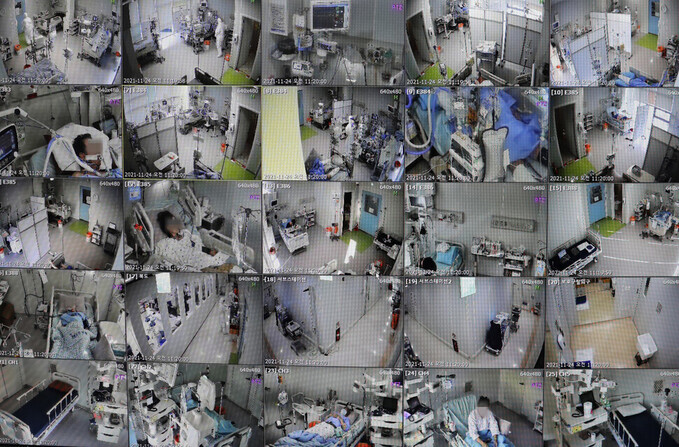hankyoreh
Links to other country sites 다른 나라 사이트 링크
Why COVID-19 patients in S. Korea are hospitalized at a rate 10 times higher than in the UK

The percentage of COVID-19 patients in South Korea who have been hospitalized is markedly higher than in other countries, a study has shown.
Analysts are stressing the need for South Korea to reduce its hospitalization rate through broader application of at-home care and more efficient administration of hospital beds.
On Thursday, the Health Insurance Review and Assessment Service published an analysis of data from the Organisation for Economic Co-operation and Development and the websites of different countries’ health ministries.
The findings showed COVID-19 patient hospitalization rates of 4.59% for the UK and 6.59% for Singapore — less than half the 20.2% of South Korean patients that the Central Disaster Management Headquarters (CDMH) tallied as hospitalized in a November survey.
Japan, which had the highest number of hospital beds (12.8) per 1,000 people, also had a lower rate of COVID-19 patient hospitalization than South Korea at 13.8%. South Korea currently has 12.4 beds available per 1,000 people.
The analysis did not include patients currently staying at residential treatment centers, a type of isolation and treatment support facility for patients with mild symptoms that only exists in South Korea. If they are counted, the hospitalization rate rises further to 49.8%.
In a briefing Wednesday, Son Young-rae, a senior health official at the CDMH, explained, “South Korea has continued to expand its use of at-home care since early this year, but as of the first week of December, an average of only 50.2% of all confirmed patients have been recuperating at home.” This means that around half of all patients are being treated at a hospital or other facility.
The high hospitalization rate of COVID-19 patients in South Korea can be attributed to the automatic application of the contagious disease response manual, which legally classifies COVID-19 as a “Level 1 contagious disease” for which patients must be isolated in negative pressure wards for treatment.
With a large number of beds available and fewer confirmed cases than in other countries, South Korea has long been able to keep hospital-based treatment as its default approach.
“When the first [COVID-19] wave erupted in Daegu last year, the deaths of patients at home while waiting [for hospital beds] led to people perceiving at-home recuperation as a form of neglect,” Yoon Tae-ho, a professor of preventive medicine at Pusan National University, told the Hankyoreh.
“Since the Middle East Respiratory Syndrome (MERS) outbreak [in 2015], there’s been a strong sense that the state needs to take responsibility for its citizens’ lives, and I think people felt that when it comes to contagious diseases, the government should be treating patients in facilities,” he said.
But with the preventive effects of vaccines dwindling among older people in particular and South Korea shifting its disease control approach toward a gradual return to everyday life, hospital bed occupancy rates have reached critical levels.
As of 5 pm on Wednesday, occupancy rates were above 70% for South Korea’s 12,169 dedicated COVID-19 sickbeds (70.85%), its 1,255 critical care beds (78.8%), and its 653 quasi-critical care beds (71.67%). The residential treatment center occupancy rate is 68.2% and rising.
Having run into limits with its efforts to make more beds available, the government has been focusing on increasing the use of at-home treatment. A total of 18,404 patients were subject to at-home recuperation as of the end of the day Wednesday.
In announcing their plans for increased support for at-home care, disease control authorities said it was “the only way to continue operating the healthcare system in tandem with a return to everyday life.”
By Lee Jae-ho, Kwon Ji-dam and Kim Ji-eun; staff reporters
Please direct questions or comments to [english@hani.co.kr]

Editorial・opinion
![[Column] Season 2 of special prosecutor probe may be coming to Korea soon [Column] Season 2 of special prosecutor probe may be coming to Korea soon](https://flexible.img.hani.co.kr/flexible/normal/500/300/imgdb/original/2024/0426/3317141030699447.jpg) [Column] Season 2 of special prosecutor probe may be coming to Korea soon
[Column] Season 2 of special prosecutor probe may be coming to Korea soon![[Column] Park Geun-hye déjà vu in Yoon Suk-yeol [Column] Park Geun-hye déjà vu in Yoon Suk-yeol](https://flexible.img.hani.co.kr/flexible/normal/500/300/imgdb/original/2024/0424/651713945113788.jpg) [Column] Park Geun-hye déjà vu in Yoon Suk-yeol
[Column] Park Geun-hye déjà vu in Yoon Suk-yeol- [Editorial] New weight of N. Korea’s nuclear threats makes dialogue all the more urgent
- [Guest essay] The real reason Korea’s new right wants to dub Rhee a founding father
- [Column] ‘Choson’: Is it time we start referring to N. Korea in its own terms?
- [Editorial] Japan’s rewriting of history with Korea has gone too far
- [Column] The president’s questionable capacity for dialogue
- [Column] Are chaebol firms just pizza pies for families to divvy up as they please?
- [Column] Has Korea, too, crossed the Rubicon on China?
- [Correspondent’s column] In Japan’s alliance with US, echoes of its past alliances with UK
Most viewed articles
- 1AI is catching up with humans at a ‘shocking’ rate
- 2‘We must say no’: Seoul defense chief on Korean, USFK involvement in hypothetical Taiwan crisis
- 3[Column] Season 2 of special prosecutor probe may be coming to Korea soon
- 4Is Japan about to snatch control of Line messenger from Korea’s Naver?
- 5Up-and-coming Indonesian group StarBe spills what it learned during K-pop training in Seoul
- 6The dream K-drama boyfriend stealing hearts and screens in Japan
- 7Is N. Korea threatening to test nukes in response to possible new US-led sanctions body?
- 8S. Korea “monitoring developments” after report of secret Chinese police station in Seoul
- 9Ferry accident likely due to whale; 1 killed
- 10[Column] ‘Choson’: Is it time we start referring to N. Korea in its own terms?